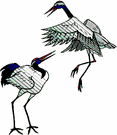
The photo is of my dop, Chase, who is about to get his prey--a leaf flying across the parking lot at Lake Hasty. The strong winds have been a boon for Chase as there have been hundreds of blowing leaves to apprehend. Chase is very attuned to things that blow or fly--when I first took him to a reservoir I found he would watch the gulls, Turkey Vultures and even an airplane. I am always happy to have him chasing inanimate prey objects like leaves.
On my way back home yesterday from the lower Arkansas Valley I stopped at Lake Hasty, which is below the dam at the John Martin Reservoir. Though sometimes fairly protected here, the winds were still quite strong. Most of the waterbirds were congregated by some islands in this smaller lake, including 15 or so Great Blue Heron, about 20 American White Pelicans, several Double-crested Cormorants and some Ring-necked and California Gulls.
I was surprised to see a juvenile Black-crowned Night-Heron fly out of a wetland area. Then 2 terns flew in--at first they looked like Least Terns, but there was only black eye patch and black bill. After checking my books when I got home very late last night, I found that first winter Forster's Terns have these plumage and bill characteristics.
At nearby Verhoef Res, a private area that must be scoped from the highway, a flock of 25 Am White Pelicans braved the strong winds to fly into this pond. Even with their massive 9 foot wingspans, the winds were difficult even for them. Nearby a large flock of 60-70 American Crows, a species that seems to excel at flying in strong and gusty winds, played with the wind currents as they moved in a loose flock.
I stopped at the Valley Grocery in the nearby (tiny) town of Hasty. The only other business in the town is the post office which is located across from the grocery, both on the corner of Main St and H50. I always encourage birders to try to make purchases in the local establishments as this is how we show rural folks that birds are good for their economies and thus they should be protected. The Vally Grocery is a favorite of mine--they always have brewed iced tea and there are always some locals there. The prices are outragiously inexpensive--they don't charge extra for being in the middle of nowhere as some establishments do. They are a great place to stop for beverages and snacks, friendly service, and clean restroom.
There were more Am White Pelicans on John Martin Reservoir, likely more than the 75 I saw. While driving next to the north John Martin State Wildlife area, I found 5-6 Yellow-headed Blackbirds in a mixed flock of Red-winged and Brewer's Blackbirds and Starlings. Though I didn't find any Shorted Eared Owls, I did see a Great Horned Owl. And I saw another large flock of 85-95 American Crows. At two playas in Crowley County I saw two yellowlegs, one appeared to have the upturned bill of a Greater Yellowlegs.
Yesterday and today I saw about the same number of Northern Harriers (9) as Red-tailed Hawks. I also had a nice Ferruginous Hawk yesterday near Lamar that I watched catch and eat a large snake.
SeEtta







































